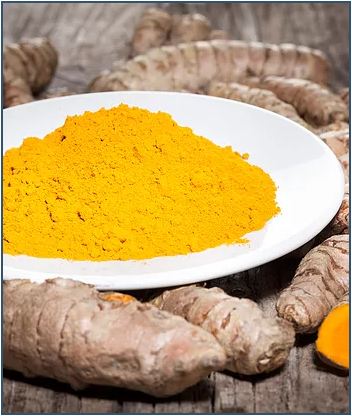Curcumin

Turmeric (curcumin) has been used in Chinese and Ayurvedic medicine for thousands of years to treat digestive complaints, liver disorders, immune dysfunction and as an antiseptic.
Turmeric is a member of the ginger family and is native to Asia. Curcumin is a yellow phytochemical produced in the rhizomes of the turmeric plant. Recent research has found that turmeric has anti-inflammatory, antioxidant and anti-tumor actions making it potentially useful for treating a variety of degenerative disease including arthritis, Alzheimer’s, heart disease and cancer. Research also suggest that curcumin has strong potential in both treating and preventing a variety of types of cancer including breast, colorectal, prostate, pancreatic, skin, and lung.
Curcumin has been shown to have multiple effects, targeting a variety of receptors on cancer cells. The chemopreventive actions of curcumin include inhibition of cancer cell proliferation through cell cycle arrest at various phases depending on the cell type, induction of apoptosis or apoptosis-like changes within mitochondria-mediated pathways, and suppression of angiogenesis and metastasis. The antioxidant and anti-inflammatory properties of curcumin have demonstrated protection against carcinogenesis, preventing tumor formation and the development of several cancer types.
Topical application of curcumin on external cancerous lesions significantly reduced itching, pain and size of the lesions. Curcumin was also found to significantly improve: dyspepsia, osteoarthritis, stomach ulcers, submucosal fibrosis, blood lipid levels, and submucosal fibrosis when compared to placebo groups in various studies and randomized, double-blind, placebo-controlled trials.
References:
- Hartojo, W., Silvers, A. L., Thomas, D. G., Seder, C. W., Lin, L., Rao, H., … Chang, A. C. (2010). Curcumin promotes apoptosis, increases chemosensitivity, and inhibits nuclear factor kappaB in esophageal adenocarcinoma. Translational Oncology, 3(2), 99–108. http://doi.org/10.1593/tlo.09235
- Kanai, M. (2014). Therapeutic applications of curcumin for patients with pancreatic cancer. World Journal of Gastroenterology : WJG, 20(28), 9384–9391. http://doi.org/10.3748/wjg.v20.i28.9384
- Anuradha, C. A., & Aukunuru, J. (2010). Preparation, characterisation and in vivo evaluation of Bis-demethoxy curcumin analogue (BDMCA) nanoparticles. Tropical Journal of Pharmaceutical Research, 9(1), 51–58. http://doi.org/10.4314/tjpr.v9i1.52036
- Dhillon, N., Aggarwal, B. B., Newman, R. A., Wolff, R. A., Kunnumakkara, A. B., Abbruzzese, J. L., … Kurzrock, R. (2008). Phase II trial of curcumin in patients with advanced pancreatic cancer. Clinical Cancer Research, 14(14), 4491–4499. http://doi.org/10.1158/1078-0432.CCR-08-0024
- Carroll, R. E., Benya, R. V., Turgeon, D. K., Vareed, S., Neuman, M., Rodriguez, L., … Brenner, D. E. (2011). Phase IIa clinical trial of curcumin for the prevention of colorectal neoplasia. Cancer Prevention Research, 4(3), 354–364. http://doi.org/10.1158/1940-6207.CAPR-10-0098
- Epelbaum, R., Schaffer, M., Vizel, B., Badmaev, V., & Bar-Sela, G. (2010). Curcumin and gemcitabine in patients with advanced pancreatic cancer. Nutrition and Cancer, 62(8), 1137–1141. http://doi.org/10.1080/01635581.2010.513802
- Kanai, M., Yoshimura, K., Asada, M., Imaizumi, A., Suzuki, C., Matsumoto, S., … Aggarwal, B. B. (2011). A phase I/II study of gemcitabine-based chemotherapy plus curcumin for patients with gemcitabine-resistant pancreatic cancer. Cancer Chemotherapy and Pharmacology, 68(1), 157–164. http://doi.org/10.1007/s00280-010-1470-2
- Bayet-Robert, M., Kwiatkowski, F., Leheurteur, M., Gachon, F., Planchat, E., Abrial, C., … Chollet, P. (2010). Phase I dose escalation trial of docetaxel plus curcumin in patients with advanced and metastatic breast cancer. Cancer Biology & Therapy, 9(1), 8–14. http://doi.org/10.4161/cbt.9.1.10392
- Lin, L., Liu, Y., Li, H., Li, P.-K., Fuchs, J., Shibata, H., … Lin, J. (2011). Targeting colon cancer stem cells using a new curcumin analogue, GO-Y030. British Journal of Cancer, 105(2), 212–20. http://doi.org/10.1038/bjc.2011.200